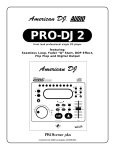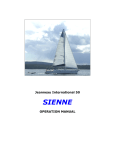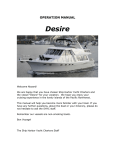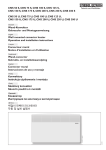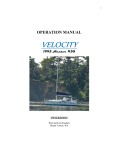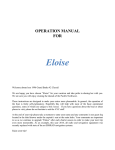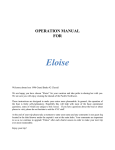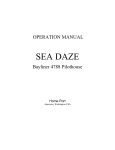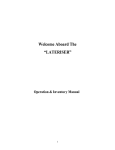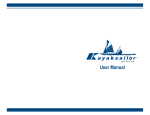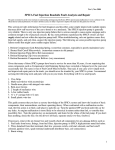Download OPERATION MANUAL - Ship Harbor Yacht Charters
Transcript
OPERATIONS MANUAL Welcome Aboard! Chinook We are happy that you have chosen Ship Harbor Yacht Charters and the vessel Chinook for your vacation. We hope you enjoy your cruising experience in the lovely islands of the Pacific Northwest. This manual will help you become more familiar with your boat. If you have any further questions, about the boat or your itinerary, please do not hesitate to ask the SHYC staff. Remember our vessels are non-smoking boats. Bon Voyage! The Ship Harbor Yacht Charters Staff TABLE OF CONTENTS General Description - Chinook Boat Operation Engine Inspection Bilge Pumps Engine Start-Up Fuel Tanks Engine Shutdown Getting Underway Cruising Docking Fueling Boat Electrical A.C. (110v Shore) Power D.C. (12v House) Systems Batteries Sanitation System Marine Toilet Holding Tank Y-Valve Water Systems Fresh Water Tanks Fresh Water Pump Hot Water Shower Galley Propane Refrigeration Stove/Oven Heating Systems Diesel Heater (DC) Electronics VHF Radio, Depth Sounder GPS Stereo/CD/Radio DVD Player Page 3 3 4 5 6 7 8 9 10 11 11 12 13 13 14 -2- Anchoring Sails and Rigging Main Genoa Spinnaker Barbeque Dinghy/Outboard Other Notes 14 15 16 16 17 Safety Crabbing Dead Heads/ Debris Deck Fill Diagram Thru-Hull Diagram Fresh Water System Diagram 18 19 20 GENERAL DESCRIPTION - Chinook Model: Documentation No: Hull ID: State Reg’n No: Beneteau Idylle 11.50 685719 BEY 01420A525 11632 Length Overall: Length of Waterline: Beam: Draft: Height from Water: 37’ 7” 30’ 4” 12’ 2” 6’ 4” 52’ Main Sail Genoa Sail: Symmetrical Spinnaker Displacement: Ballast: Engine Fuel Capacity: Water Capacity: Holding Tank Capacity: 146% 11,440 lbs 4,860 lbs Perkins 50 hp diesel 50 gal diesel, S/S tanks (30g & 20g) 90 gal in two S/S tanks 14.5 gal BOAT OPERATION Engine Inspection Remember your “WOBBS” every morning. (Water (Coolant), Oil, Bilges (Inspect and Pump-out), Belts, and Sea Strainer. Remove lower stair panel to access front of engine and the angled panel in the aft stateroom to access the rear of engine. -3- • • • • • Check the Water level of COOLANT in the expansion tank. Check the Oil level of your engine with the dipstick. Look at the etch mark on the dipstick that indicates proper levels. DO NOT OVERFILL! Fill only if oil level are below the ½ mark. Check the Bilges for excessive fluids. Check the general condition of the Belts and hoses. Check the Sea strainer for debris. Ensure the SEA WATER VALVE is OPEN! (Lever in-line with valve). If cleaning is necessary, close the thru-hull valve, open the strainer lid, clean out debris, and reassemble. REOPEN the Thruhull Valve! Engine Front Engine Rear Bilge Pumps Chinook is equipped with two automatic bilges pumps that can be manually activated on the DC panel. The switch should normally be left in the “Auto” position can be switched for a minute or so to “manual” to pump the bilge. If you continually hear the bilge pump running, check your bilge! You may have a serious problem! The Forward Bilge Pump is accessed under the center of the salon table. The Rear Bilge Pump is located behind the engine under the fwd cushion panel of the Aft Stateroom. An auxiliary hand-operated bilge pump is located on the stbd transom deck and operated by a handle stored in the stbd transom locker. This is used in an emergency situation. -4- Engine Start Up Chinook has a 50 hp Perkins diesel engine with a 2 bladed prop. There is an ignition, throttle and transmission control in the cockpit. The vessel cruises at 2000 - 2200 rpms to a speed of 6 knots. Running your engine much above that will burn a lot more diesel at the gain of very little boat speed. The boat has a definite prop walk to port in reverse with not too much noticeable effect in forward. When in reverse, be careful to keep a firm grip on the wheel. It is best to use only low rpms in reverse to minimize the prop walk to port. To start engine • Rotate the battery selector switch (behind the aft stateroom door) clockwise to the horizontal position. • Place transmission in the neutral position (Throttle arm straight up with button out). • Press the button on the side of the throttle in and move throttle forward to advance the throttle & fuel. • If the engine is cold, first preheat it by turning key clockwise (one position) to the preheat position for about 15 seconds. Your oil and temperature alarm will sound. Turn key all the way over. Do not hold the start button for more than 15 seconds at a time. If the engine does not catch the first time, wait about 15 seconds before trying again. NEVER TURN OFF THE KEY WHILE ENGINE IS RUNNING • After the engine starts, warm it up for about 5 minutes at about 1500 rpms. Check the aft stb exhaust outlet for water and exhaust as an indication that your thru-hull is open and water is keeping your engine cool. Observe your gauge readings: • Oil Pressure around 50 psi. • Water Temp around 140 degrees. • Engine temperature should rise very slowly. Note: If water temp is high or oil pressure low, shut down engine and look for problem. Was there a lack of water exiting with exhaust? Are thru-hulls open and debris cleared from sea-strainer? If problem keeps occurring, call SHYC Service. -5- Fuel Tanks The Chinook has two diesel fuel tanks (30 gal Main & 20 gal Aft). Fuel supply & return lines should be set up to run on one tank at a time. Fuel tank valves are located behind the engine under the fwd cushion panel of the Aft Stateroom. To Switch Fuel Tanks: • Remove cushion & panel. • With engine running, open Aft Tank Supply valve and Aft Tank Return valve. • After one minute, close Main Tank Supply valve and Main Tank Return valve. • Use reverse procedure to change back to Main Tank Supply. Note: It is very important to follow this procedure to prevent air from entering the injection system which may require bleeding the fuel lines and injectors. You don’t want to go there! It can ruin your day! Engine Shut Down Before shutting down, let engine idle for about 5 minutes to cool. Ensure the gearshift is in the neutral position and the throttle is in idle. To turn off the engine: • Rotate the key counter clockwise and hold down the black rubber kill button. Getting Underway Disconnect the shore power cord (see AC Power next page). Close portholes, windows, and hatches. Turn on VHF and electronics. Assign crewmembers to their tasks. Put one crew member (the “dingiest” member of course!) in charge of the dinghy if it is under tow. It needs to be kept on a tight leash when in the marina. Once outside marina, have crew members bring in fenders and put lines away. Cruising Slowly come up to cruising speed of 2200 rpms where you will cruise at approx. 6 knots, using only 3/4 gallons of diesel/hour. Using excessive rpms will only give you a ½ knot of speed and will only damage the engine. Speed will vary depending on weight, load, current and weather conditions. -6- Docking During docking, give clear instructions to the crew on what you will expect of them i.e. with lines and fenders. Always come into the dock slowly allowing for any wind or tide. If you have a choice, dock on the port side because as you put the transmission in reverse, she will pull to port sucking you in closer to the dock. Have the bow, stern, and spring lines ready. If you are short on crew, lead the lines to the mid section of the boat (where it is fattest) where your crew member can easily step off with one of the lines, secure it, and quickly grab the next one. As you are approaching the dock, have your crew call out distances to the captain (ie 20 feet, 10 feet, 3 feet etc.). This will help with a successful landing. If you find you are too far from the dock, DO NOT have your crew jump! Back out and do it again. Disaster will follow if someone falls in the water. Fueling Up You will need to fill up upon completion of your charter. Your Main Fuel tank holds 30 gallons and the Aft Fuel tank holds 20 gallons. You should have a rough idea of the number of gallons you will need to add to your tank. (e.g. you use 3/4 gal per hour and have run 18 hours = 13 gal.) Open both fuel filler caps located on the transom with the key located in the Nav station. MAKE SURE YOU HAVE DIESEL! Make sure it is going into the right deck fill! DOUBLE-CHECK! Before pumping, have your oil/fuel sorb ready to soak up any spilled fuel. Do not add water at the same time. Put the Diesel nozzle into the deck fitting and pump slowly listening to the sound of the flow. Pumping too fast may not allow excess air to escape, which will lead to spillage out the vent. As the tank fills, the sound will rise in pitch or gurgle. Pay attention to the vent that it does not spill fuel into the water. Top off carefully, catching any spillage with your sorb. Check your gauges. Replace the deck fill caps and clean up any spatter and wash hands thoroughly. BOAT ELECTRICAL The electrical system is divided into two distribution systems: 110 volt or AC and 12 volt or DC. The systems are controlled from the electrical panel located at the nav station and the battery switches located behind the door to aft stateroom. When not connected to shore power your batteries provide most of your electrical power. Therefore the use of onboard electricity needs to be monitored very carefully. Turn off electrical devices when they are not being used (lights, the instruments, etc.) 110 Volt or AC (Alternating Current) Shore Power supports all AC equipment and receptacles on board as well as the battery charger. -7- To connect to 30 amp shore power, plug the power cord into the boat and then into the dock receptacle. Check your power rating/plug size of the dock receptacle (i.e. 30amp, 20 amp etc.) Secure the cord around the shore power electrical receptacle and off the bow (i.e. wrap around bowline a few times) turn the dock power breaker on. On the boat, turn the shore circuit breaker on at the electrical panel. Turn on appropriate breakers for battery charger, refrigeration, water heater, and house lights. Watch your voltmeter for load. If the load exceeds the voltage, it will pop the breaker. If this occurs, wait to turn on one of your systems (i.e. water heater) until the use of power decreases. Inverter The Chinook is equipped with a portable 400w inverter to provide 110v AC power for a computer or recharge camera batteries and the like when not connected to shore power. It does not supply power to the 110v outlets, water heater or battery charger. The inverter plugs into the 12v DC outlet. House 12-volt System Three battery banks support your 12 volt system. Two are wired in parallel for the House System and the other battery is for the Engine Start. They are located under the fwd cushion in the aft stateroom. The battery switches are located behind the door to the aft stateroom: • ANCHOR WINDLASS SWITCH • ENGINE BATTERY SWITCH • HOUSE BATTERY SWITCH • GROUND SWITCH The Anchor Windlass Switch should be always be turned off (horizontal position) except when in use. You should never operate the windlass unless the engine is running. This will bleed your batteries very quickly. The Engine Battery Switch should always turn off (horizontal position) when the engine is not running to guarantee starting power at all times. Note: Changing the position of the battery switches with the engine running will cause damage! Only change positions with the engine off! The Ground Switch should always be the first switch to be turned on and the last to be turned off. It disconnects the ground for the entire boat except for the two electric bilge pumps. Switches are off in the vertical position & on in the horizontal position. Normally you will leave the switches on while the engine is running (except for the Anchor Windlass). Your 12 volt panel shows all the systems supported by your batteries. • Primarily you will be turning on these breakers for refrigeration, cabin lights, water pressure, electronics, etc. • Bilge pumps bypass the panel and are wired directly to the battery so they will always be left on. • Your propane switch (located on the panel under the front of the galley sink) should be turned off after every use. -8- When disconnected from shore power, the 12–volt systems will drain the battery especially when at anchor. Monitor your batteries very carefully. Charging the batteries each day for 30-45 minutes is recommended. The DC voltmeter on the DC panel can be switched between your battery banks to measure battery voltage. Typically the bank should read from about 13.0 to 14.5 volts when being charged. While at rest, your voltage will drop as indicated in the figures below. All your batteries are charged while underway by the alternator. The engine and house batteries are charged by the battery charger while connected to shore power. Ensure that the Battery Charger breaker is turned on when connected to shore power. Voltage 12.65 volts 12.47 volts Battery State of Charge 100% 75 % 12.25 volts 11.95 volts 11.70 volts 50 % 25 % 0 % Fuses Required for Equipment: 3 Amp Battery Charger Indicator Lights 5 Amp Anchor Light Streaming Light Nav Station Equipment 10 Amp Navigation Lights Water Pump Bilge Pumps Engine Hour Meter 20 Amp Refrigerator -9- SANITATION SYSTEM Marine Toilet (RARITAN PHII) It is imperative that every member of the crew be informed on the proper use of a marine head. The valves, openings, and pumps are small and will clog easily. If the head gets clogged, it is your responsibility! Always pump the head for small children so you can be certain of what is being flushed. Note: Never put in paper towels, napkins, sanitary products, household T.P., or food into marine heads. Use only marine T.P. provided by SHYC. To use toilet, move selector switch to the “wet bowl” position. Pump the handle 3-5 times to wet the bowl. After using head, clean waste from bowl with bowl brush and flush 2-3 times. Then return selector back to “dry bowl” position and pump for a few times until bowl is dry. Your toilet raw water intake is located directly to the left of the toilet if you should need to shut off the water to the toilet. Should the toilet squeak or be a bit sticky to pump, lubricate with a couple of squirts of dish soap or salad oil. Put in bowl and pump 2-3 times to get it to pump and leave overnight. Again, leave in the “dry bowl” position. Holding Tank Your sanitation holding tank holds 14 gallons. Be aware of the rate of waste production (about 1 gallon/flush). If you overfill your tank, you will break a hose, clog a vent, or burst the tank which is an indescribable catastrophe! And a very expensive fix for you. Empty the tank at least every other day to avoid any problems. The holding tank is located starboard stern lazarette. Some may be subject to a visual check with a flashlight or the “watermelon test” by thumping it. Emptying Holding Tank: 1/ Pump-out Station - At the pump-out station, remove the deck waste cap located starboard side midship. Insert the pump-out nozzle into the waste opening. Double-check that you have the right deck opening! Turn on the pump on the dock and open the valve on the handle of the hose. When pumping is finished, close lever on handle and turn off pump. Remove from deck fill. If there is a fresh water hose on the dock, rinse the tank by adding water for 1-2 minutes. Then re-pump to leave the tank rinsed and clean for the benefit of the next charterer. This also eliminates any head odors. 2/ Discharge at Sea - The tank’s contents can also be discharged at sea by using the macerator pump. To operate the macerator, open thru-hull by lifting the lever located in the cockpit starboard deep locker, depress macerator switch on the shelf edge, and pump until pitch becomes higher indicating an empty tank. This should take about 2 minutes. Discharge can be seen on the starboard side of the boat. - 10 - Note: Overboard discharge is only allowed in Canadian waters. It is illegal to discharge overboard within U.S. waters. Y-Valve The Y-Valve directs the flow of waste into the holding tank or directly overboard. The Y-Valve is located in the locker directly behind the head. To flush directly overboard, rotate the handle in line with the overboard hose. Because of Coast Guard regulations the Y-Valve is wire-tied to the holding tank position. WATER SYSTEM Fresh Water Tank/ Pump/ Hot Water Heater The fresh water tanks hold a total of 90 gallons total and are located under the port and starboard settees in the main salon. Port & Stbd tank shut off valves are located under the settee cushion fwd of the galley sink. The galley sink cold water is filtered (under the galley sink). The galley sink is equipped with a salt water foot pump for initial washing and save valuable fresh water. The galley sink is also equipped with a fresh water brass hand pump (priming may be required). Waste water from the sinks drain overboard through various thru-hulls usually located under the sinks. To fill the tanks, remove the deck water fill caps located port side midship. Fill the tank avoiding flushing debris into the tank. Do not fill water and diesel at the same time! - 11 - The water pressure pump is located under the galley sink. Activate the pump by turning on the Water Pressure breaker at the DC panel. If the pump continues to run, you are either out of water or have an air lock which can be corrected by opening a faucet. If you run out of water, shut off pump and turn off hot water heater on AC panel. You can cause serious damage to the heating element. The hot water heater has a 10 gallon capacity. It is heated when the AC breaker is on while connected to shore power. Do not use the water heater if the water level is low. The water heater is located in the starboard deep lazarette. Shower Before taking a shower, make sure the water pressure breaker is on. Take short “boat” showers by turning off the water between soaping and rinsing. Please wipe down the shower and floor when finished to keep shower tidy. Pick up any accumulation of hair in the drains as it clogs the hoses. Ensure that the faucets are tightly turned off after each shower to save water. The shower drains into the fwd bilge and automatically discharges automatically. The strainer for the shower drain, (requires cleaning periodically) is located in the front starboard side of the engine. Remove the stairs, unscrew the filter cup and clean. Replace the cup. Do not over cup tighten screw. GALLEY Propane The boat is equipped with a pressurized 4 gal propane system for cooking. The propane tank is located under the aft cockpit seat. Open the tank valve. Then turn on the red propane solenoid switch in front of the galley sink. When lighting the first - 12 - time, allow a few seconds for the gas to travel from the tank to the stove. You might need to keep the stove top or the oven in the light position for a few more seconds while the thermo-coupler warms up. To ensure safety, turn off the propane solenoid switch in the galley and at the propane bottle, when finished. Refrigerator The refrigerator operates on 12 volt. Carefully monitor the use of the refrigerator when the engine is not charging the 12-volt system as when you are at anchor. Use a cooler when possible for all your drinks to keep the refrigerator door closed as much as possible. Charging the batteries each day for 30-45 minutes is recommended. HEAT A Dickinson diesel cabin heater is located on the fwd salon wall. The fuel pump is located under the settee cushion fwd of the galley sink. A red switch located on the fwd side of the settee activates the heater pump and fan. DO NOT OPERATE THIS PRODUCT UNATTENDED or WHILE SLEEPING. - 13 - To Start: • Turn on power/pump switch. • Turn oil metering valve on to position #1, let oil run in for 1 to 2 minutes • Open the heater door and place a small twisted piece of lit toilet paper into burner tower. Use the auger tool to push lighted tissue off to the side to the fuel below. • Close the door and turn on the combustion assist fan assist to medium low. • In about 5 minutes the flame will rise up to the burner ring. • Keep oil meter valve on the #1 for 30 minutes before selecting higher settings. • INCREASE FUEL SETTINGS IN VERY SMALL INCREMENTS (1/2 to 1) at a time, 5 minutes apart. • When the flue pipe is hot (20 minutes of burning) the assist fan may be turned OFF or on a low setting. CAUTION: NEVER LIGHT A FLOODED BURNER To Shut Down: • Turn off the power/pump switch and fan. • Turn off oil metering valve. ELECTRONICS Navigation Electronics: • • • Standard VHF Radio. Make sure the DC NAVCOM breaker and Instrument Light S/W is on. Always monitor Channel 16 while underway. JVC Stereo Deck with CD changer and ipod adapter. Toshiba DVD player with remote operates via a 12v outlet mounted in the shelf storage behind the settee. Cockpit Electronics: • • • • Autohelm Depth Sounder is located on the port cockpit bulkhead. To activate, ensure that the DC NAVCOM breaker and Instrument Light S/W is on. The sounder is reliable in waters less then 200 feet and at slower speeds. If your reading is blinking, it might be a false reading due to excessive depths or strong currents! Watch your depth carefully in cruising unknown waters that might have rocks or obstacles. Autohelm Autopilot is located on the port cockpit bulkhead. Wind Indicator is located on the starboard cockpit bulkhead. This reads the apparent wind direction and the apparent wind speed. Lowrance GPS is located on the binnacle. ANCHORING Your primary working anchor, a 35# CQR, is attached to 290 ft of rode (90 ft of chain and 200 feet of rope. The chain and rope are marked every 10 ft. TO LOWER ANCHOR: • Keep all hands clear of chain and moving parts. • Release the windlass brake slowly. (play out chain slowly). - 14 - • • Set anchor to prescribed scope. Always attach anchor snubber line to chain and attach to deck pad eye to reduce strain on windlass. TO RAISE ANCHOR: • Turn on the Anchor Windlass Switch behind the Aft Stateroom door. • Always have your engine running when operating the anchor windlass. • Raise the anchor using the foot switch in small increments. Anchor locker is small and chain stowage will have to be manually adjusted. • Always motor vessel forward as anchor is being raised to reduce strain on windlass. • Always motor vessel forward to break anchorage. Do not use windlass motor to break anchorage. This can cause severe damage to windlass. • Turn off the Anchor Windlass Switch when finished. A spare 10 # Danforth anchor is located on the transom rail with 100 ft of spare rode stored in yellow bag on the shelf in the cockpit deep locker. SAILS AND RIGGING Mainsail To raise • • • the Mainsail: Remove the sail cover and straps. Slacken the traveler and boom vang. Release the main cam cleat and raise the main. Make sure the tack is hooked on the boom horn. Tighten and lock the cam cleat. • Release and slacken the red topping lift line on the mast. • Tighten the boom vang. • Tighten and set the traveler to the appropriate position. To lower • • • • • the Mainsail: Release and slacken the traveler and boom vang. Raise the topping lift on the mast. Release the main cam cleat and lower the main. Fold main and wrap with (4) straps. Replace sail cover. Genoa A 146% Genoa is stowed on a roller furler. The furling line runs on the starboard side to the cockpit. Genoa sheets are led back to the cockpit to two winches. Adjust fairleads forward in heavy air, aft in light wind. To unfurl the Genoa: • Uncoil the furling line. • Uncleat the sheet lines. • Wrap the sheet line around the appropriate winch and pull line aft. • Winch up and cleat when tuned appropriately. To furl the Genoa: • Head up wind and pull in the furling line applying slight tension on the Genoa sheet line until there are 2-3 wraps of line around the sail. • Tie off the sheet lines and coil the furling line. - 15 - Spinnaker A Tri-Radial Symmetrical Spinnaker and lines are located in the fwd stateroom sail locker with a spinnaker pole located on the fwd port deck. The spinnaker is stowed in dousing chute. All lines and blocks are located in a separate bag: • Foreguy w/ block • (2) Sheets w/ snatch blocks • (2) Guys w/ blocks NOTE: Sailing a spinnaker can be fun but also dangerous and requires a minimum crew of (4) experienced at all aspects of spinnaker sailing. This crew must have the complete knowledge and experience of spinnaker rigging, deploying, dipole jibing, dousing and piloting while flying a spinnaker. Do not attempt to fly the spinnaker unless you have this experience! Sail Troubleshooting: Main resists being raised: Check for any jammed cars in the mast track, sail caught on the rigging or hung-up lines. All reefing lines should be loose as well as the boom vang. Ensure that the tack is hooked in the horn. Furling line gets stuck: Check the tension applied to the sheets. Try letting the sail out and repeating the process. Be sure you are headed into the wind. You also might have an override inside the furling drum. Unable to point with reef: Maybe the reef line is not snuggged in sufficiently. Be sure lines are snug before raising main halyard. Other Problems: That’s what being a sailor is all about! But isn’t it nice when you kill that noisy engine and enjoy the sounds of the water. BARBEQUE The Barbeque is mounted on the aft port side transom rail. Carefully light unit. This Barbeque cooks fairly hot and fast so keep a good eye on your food. Please cool; wipe it down with a rag or paper towel before replacing cover. Ensure that outboard gas or any other flammables are not near barbeque. DINGHY AND OUTBOARD MOTOR Your 10’-8” Zodiac dinghy is equipped with a 4 hp Nissan engine. If not on the dinghy, the motor is stored on the aft transom rail. The dingy has a capacity of 1000 pounds or about 5 persons. Once dinghy is readied to go (PFDs etc), open the vent in the fuel tank and choke the engine once while starting. Make sure outboard is in neutral. This is a 4cycle engine and uses straight gas. No mixing required. - 16 - Please use extreme care in beaching your dinghy. Make sure the engine gets tilted up a safe distance from shore so the prop does not hit the bottom or shear the pin. Do not drag the dingy on the beach. Please lift it up with your crew. Make sure dingy is secured as the tide comes in fast in these here parts. When returning to the boat, leave your shore shoes in the cockpit and slip on your deck shoes or slippers to keep the boat neat and tidy. OTHER NOTES Safety should be paramount to your daily cruising. A man overboard drill (person?) should be discussed and practiced with an unlucky PFD as the victim. (please rinse and dry afterward before stowing). Remember that your lifejackets are stowed in the cockpit deep locker and in the fwd stateroom. A few should always be readily available. Flares and other safety equipment are located under the navigation helm seat. Always have a sharp lookout posted for logs, deadheads, or other flotsam and jetsam. A log hitting your prop can ruin your vacation. As you are traveling, the debris does seem to gather along current lines. It is sometimes best to go around these areas and miss the “mine fields”. The engine spares are located a fwd stateroom locker. They include extra oil filters, impellers, head pump, etc. Extra oil and coolant is located on the shelf in the cockpit deep locker. A spare prop is also on board and located on the shelf in the cockpit deep locker. Crabbing is fun but requires the correct license and season. Please be sure not to crab off the stern as the crab line can easily get tangled in your prop as you swing with wind or current. You certainly don’t want to be the person who has to dive over and cut the line out of the propeller. It is best to use the dinghy to set your crab pot/ring away from the boat. A partially open can of seafood catfood works well as any other bait and is less messy. Please clean up any seaweed of crab shells afterwards to keep the boat neat and tidy. - 17 - - 18 - - 19 - - 20 -




















